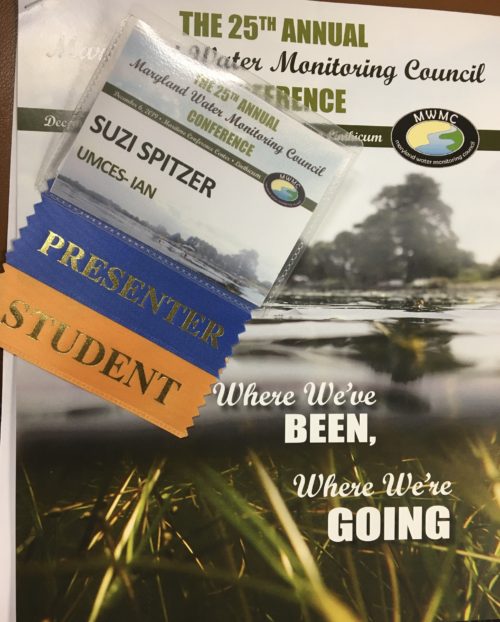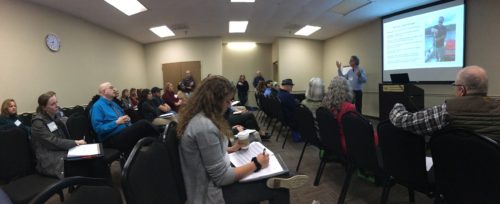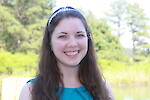Reflecting on water monitoring and citizen science at the Maryland Water Monitoring Council conference
Suzanne Webster ·On December 6th, I attended the Maryland
Water Monitoring Council conference at the Maritime Conference
Center in Linthicum, Maryland. I have attended this conference for the last few
years and I always enjoy the opportunity to network with local scientists,
environmental management professionals, educators, and others, and learn about
the latest and greatest monitoring and restoration efforts that are going on
across the state.

Maryland's Secretary of the Environment, Ben
Grumbles, gave the first of two plenary talks. During his
presentation, he touched on this year’s conference theme, “Where
we’ve been, where we’re going” when he spoke about the State’s
management progress and future directions. He encouraged us to strive for “one
water,” or integrated water resource management that challenges us to re-think
how we view and value water, embrace water re-use, and prioritize green
infrastructure. I was particularly pleased when he emphasized that it is the
government’s responsibility to tap into citizen science data and local
knowledge to make better investments and policy decisions, and also to educate
the public on what the most important issues are for the management and
restoration of the Chesapeake Bay.

Next, Nick DiPasquale, retired Director of the Chesapeake Bay Program, gave a presentation on the restoration of the Chesapeake Bay ecosystem. He first highlighted some of the lessons learned through his career, emphasizing the importance of setting clear and attainable goals, leaning on partnerships, managing expectations, targeting actions, maintaining adaptability, and increasing public access to the Bay, to name a few. Again, to my delight, he highlighted the importance of volunteer science, saying “citizen monitoring is absolutely critical for us to be able to extend our reach and understand parts of the watershed that we wouldn’t normally be able to see”. He also named a few of the challenges that the Bay Program has encountered, including politics, diversity (the lack thereof), Pennsylvania, “the damn dam” (referring to the Conowingo Dam), and climate change. Nick’s talk was a great overview of the work that the Bay Program is and has been doing, and gave us all a lot to think about.

The first concurrent session that I attended was a series of
talks related to submerged aquatic vegetation (SAV) management, moderated by my
colleague, Brooke
Landry. Speakers presented on a variety of topics, including the
history of SAV restoration in Maryland, seed harvesting and planting,
microplastics in SAV beds, and remote sensing and citizen science. Brooke gave
a talk on the recent development of a three-tiered program for monitoring
Chesapeake SAV. Last year,
IAN contributed to developing the second tier of the program when we
created the Chesapeake
Bay SAV Watchers Program, which is the first monitoring program
geared towards non-SAV experts in the watershed. It was interesting to hear how
the SAV Watchers program fits within the broader monitoring framework between
the Bay-wide
annual aerial monitoring program and the upcoming Sentinel Sites
program.

After lunch, I attended many talks focused on citizen
science, outreach, and education. Presenters spoke about many really
interesting topics, including the introduction and evolution of volunteer water
monitoring in the Severn,
the (monetary) value of volunteer-collected data in Virginia
(the answer is $3.2 million a year!), litter reduction in Prince George’s
County, and the first citizen science bacteria monitoring program in D.C. I
especially enjoyed Dionna Bucci’s presentation about her experience developing
various outreach materials as an ecologist working for Fairfax County’s Stormwater
Management Program. It was inspiring to hear how her team created a
character, Stormy
the Raindrop, and then developed various coloring books and other educational
materials featuring him, which were used in local classrooms to teach children
about stormwater management.

The conference social was hosted at Checkerspot Brewing Company, and
it was a fun time, as usual. It was a great chance to try local beer, catch up
with some old friends, and meet a few new contacts. On the tour of the brewery,
the guide talked about the importance of water quality to the brewing process,
emphasizing that “water is the first ingredient in beer”. One thing that this conference has definitely
taught me over the years is that water quality is important to a lot of
different people for a lot of different reasons! I am already looking forward
to next year’s meeting and learning more about different people’s perspectives
on how we can most effectively work together to improve the health of Chesapeake
Bay waterways.


About the author
Suzanne Webster

Suzi Webster is a PhD Candidate at UMCES. Suzi's dissertation research investigates stakeholder perspectives on how citizen science can contribute to scientific research that informs collaborative and innovative environmental management decisions. Her work provides evidence-based recommendations for expanded public engagement in environmental science and management in the Chesapeake Bay and beyond. Suzi is currently a Knauss Marine Policy Fellow, and she works in NOAA’s Technology Partnerships Office as their first Stakeholder Engagement and Communications Specialist.
Previously, Suzi worked as a Graduate Assistant at IAN for six years. During her time at IAN, she contributed to various communications products, led an effort to create a citizen science monitoring program, and assisted in developing and teaching a variety of graduate- and professional-level courses relating to environmental management, science communication, and interdisciplinary environmental research. Before joining IAN, Suzi worked as a research assistant at the Marine Biological Laboratory in Woods Hole, MA and received a B.S. in Biology and Anthropology from the University of Notre Dame.

